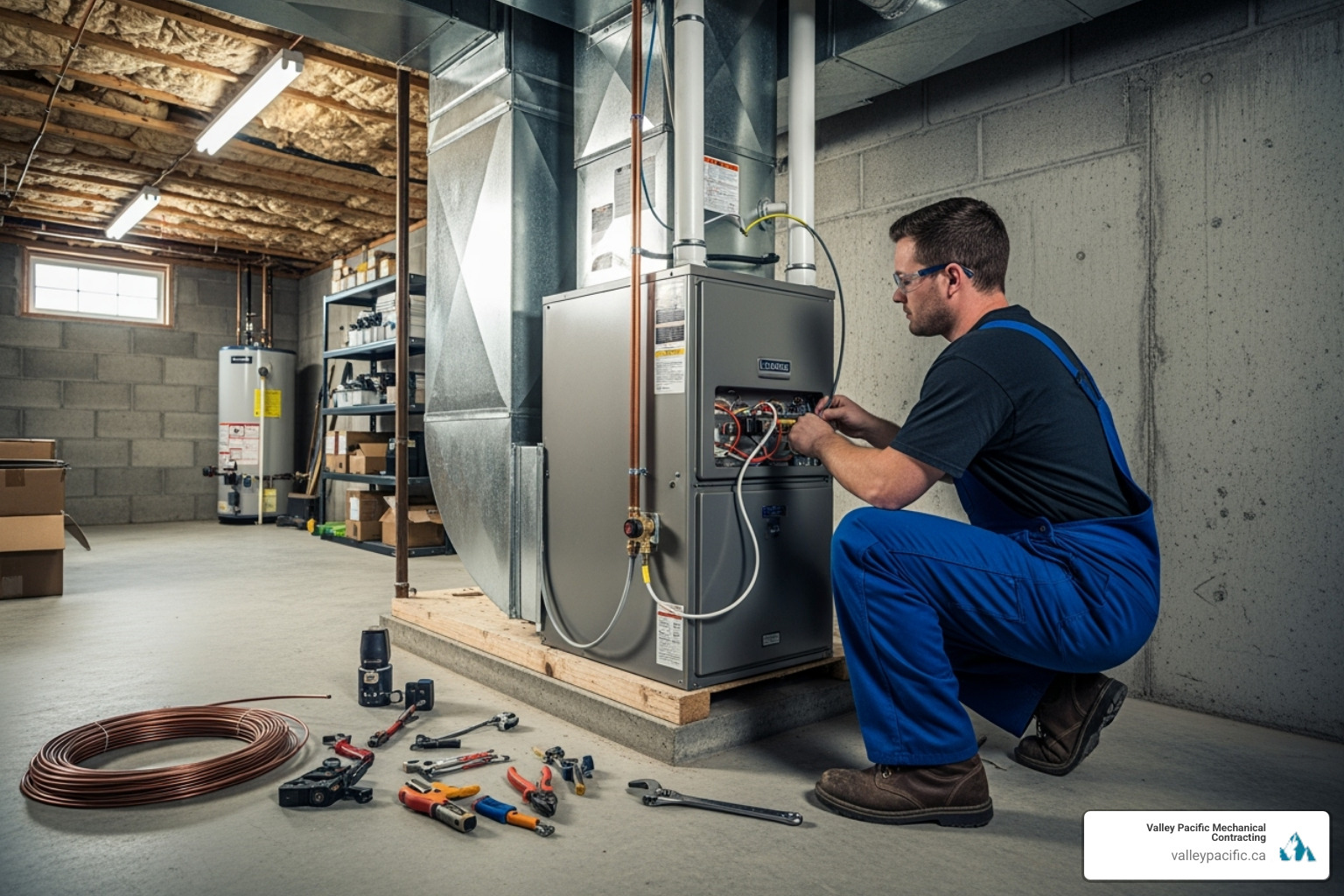Your Furnace Journey From Gas Line to Forced Air Comfort


Understanding the Forced Air Furnace Installation Journey
Forced air furnace installation is a complex process that ensures your home receives comfortable, evenly distributed warmth. It involves everything from gas line connections to calibrating the final system for optimal performance.
Key Steps in Forced Air Furnace Installation:
- Home Assessment - Load calculations and proper sizing
- Old Unit Removal - Safe disconnection of gas, electrical, and ductwork
- New Furnace Setup - Leveling, positioning, and connecting to existing systems
- Utility Connections - Gas lines, electrical wiring, and venting installation
- Commissioning - Testing airflow, pressure, and safety controls
- Final Walkthrough - System education and maintenance guidance
A forced air furnace works by drawing cold air through return ducts, heating it in a heat exchanger, and using a blower fan to push the warmed air through supply ducts to every room. This cycle of comfort depends entirely on proper installation.
Research shows that new furnaces often suffer up to a 30% reduction in performance as a result of improper installation. This means a rushed job can cost you hundreds of dollars annually in higher energy bills.
Professional installation is about ensuring your family's safety, maximizing energy efficiency, and protecting your investment for the next 15-20 years.
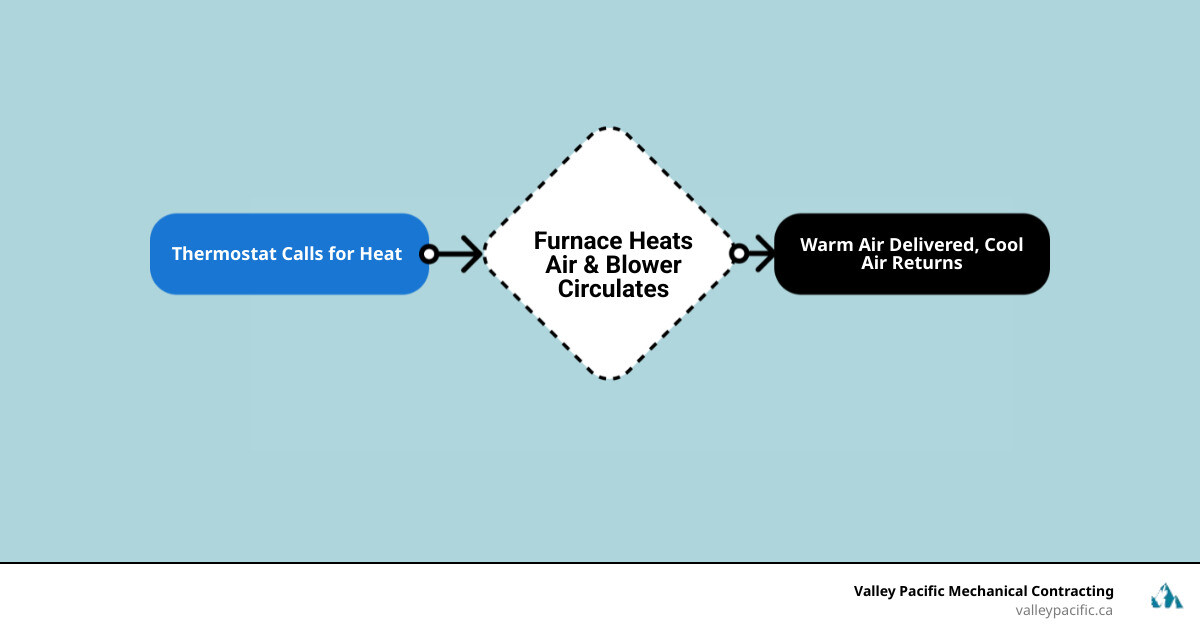
Must-know forced air furnace installation terms:
Preparing for Your New Furnace: Sizing, Selection, and Efficiency
Thoughtful preparation for your forced air furnace installation is the key to a smooth process and long-term satisfaction. A quality installation starts long before any tools are used.
We begin with a thorough home assessment to understand your home's unique heating needs. This includes a load calculation, where we examine everything from insulation and window quality to ceiling height and sun exposure. This ensures we size the furnace correctly.
Sizing the furnace is critical. An undersized unit will struggle to heat your home, while an oversized unit will cycle on and off frequently, leading to uneven temperatures and wasted energy. The quality of your insulation and windows directly impacts the furnace size you need. A well-insulated home may require a smaller, more efficient unit. If you're wondering about specifics, see our guide on How Do I Choose the Right Furnace for My Home in Pitt Meadows, BC. If your current system is aging, learn the warning signs in HVAC System May Fail Soon: Signs.
Let's talk about the AFUE rating (Annual Fuel Utilization Efficiency). A furnace with an 85% AFUE rating converts 85 cents of every dollar you spend on fuel into heat. Today's minimum standard is 80% AFUE, but high-efficiency models can reach 95% or higher. The benefits of high-efficiency furnaces include lower monthly bills, quieter operation, more consistent heating, and a smaller environmental footprint.
Choosing the Right Type of Furnace
You have several excellent options when it comes to fuel sources.
| Furnace Type | Fuel Source | Operating Principle | Best Climate Use |
|---|---|---|---|
| Gas Furnace | Natural Gas or Propane | Burns fuel in a combustion chamber, heating a heat exchanger. A blower then circulates warm air through ducts. | Ideal for colder climates with access to natural gas lines. |
| Electric Furnace | Electricity | Uses electric heating elements to warm air, which is then distributed by a blower. | Suitable for milder climates or homes without gas access. Can be costly to operate in very cold regions. |
| Heat Pump | Electricity | Transfers heat from outside air (or ground) into the home in winter, and reverses the process for cooling in summer. Can be paired with a furnace for hybrid systems. | Highly efficient in moderate climates. May require supplementary heating (often from a furnace) in very cold temperatures. |
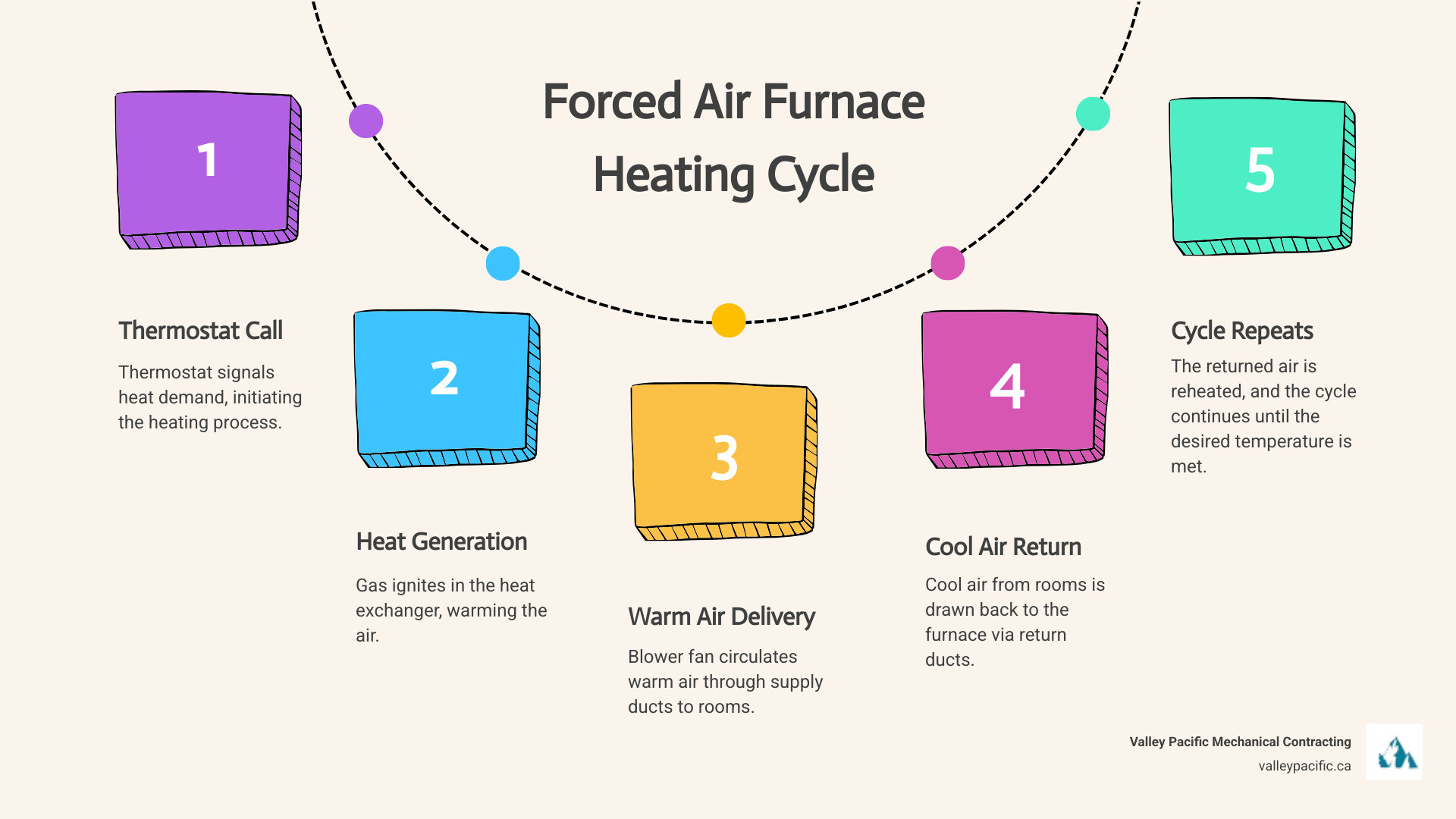
Natural gas furnaces are the most popular choice in the Lower Mainland, offering reliable and efficient heat. Propane systems are a great alternative for rural homes without natural gas access. Electric furnaces are clean and quiet, working well in milder climates. Hybrid systems combine a heat pump with a furnace, intelligently switching between the two for maximum efficiency.
Understanding AFUE and Energy Savings
Annual Fuel Utilization Efficiency (AFUE) is your furnace's energy report card. A 95% AFUE furnace converts 95% of its fuel into heat, with only 5% lost. Compared to older furnaces with 60-70% efficiency, the difference is significant.
The long-term savings from a high-efficiency unit can be substantial, paying back the initial investment through lower monthly bills over its 15-20 year lifespan. Also, look for government rebates and incentives, which can help offset the cost of upgrading to a more efficient system. We can help you identify available programs.
For more insights into forced air systems, this trusted resource provides excellent information.
The Professional Forced Air Furnace Installation Process Step-by-Step
A professional forced air furnace installation transforms your home's comfort for the next 15-20 years. Our process is designed to be a headache-free experience, prioritizing your home's safety and your new furnace's performance from day one. We follow strict safety protocols and treat your home with the utmost care.
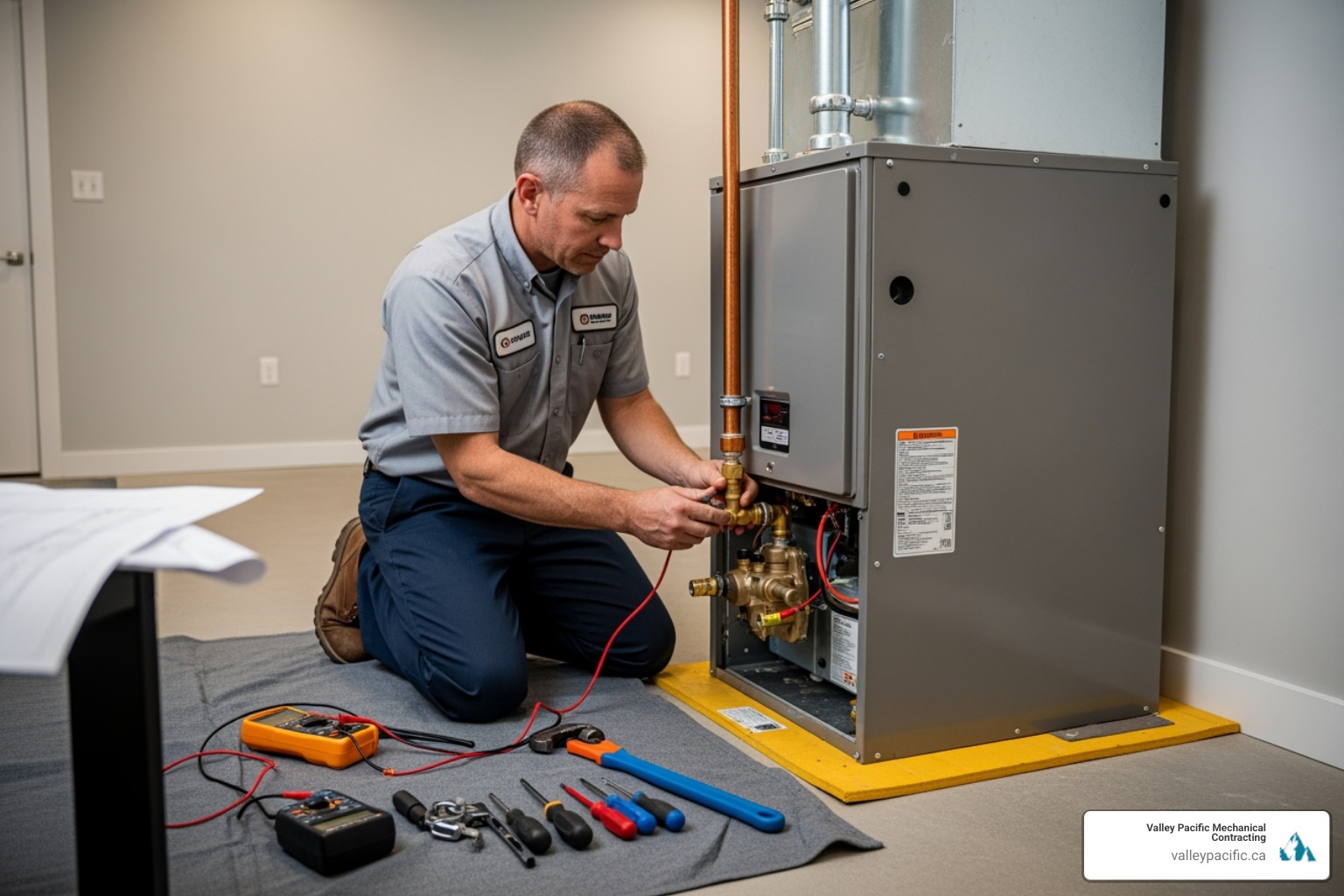
Step 1: Safe Removal of the Old Unit
A successful forced air furnace installation begins with the safe removal of your old system. Our certified technicians start by shutting off power at the circuit breaker and closing the main gas supply valve to prevent accidents. We then methodically disconnect gas lines, electrical wiring, and thermostat connections. After detaching vent pipes and ductwork, we remove the old furnace and clean the installation area, preparing a fresh space for your new unit.
Step 2: Setting the New Furnace and Ductwork Connection
Next, we prepare the space for your new furnace, ensuring it is level and stable. The unit is placed on specialized isolation pads to minimize noise and vibration while preventing rust from moisture. Connecting the new furnace to your existing ductwork is a critical step. We ensure every connection is secure and properly sealed with high-quality mastic or foil tape. This prevents air leaks, which can significantly reduce your system's efficiency. For more tips, see our Furnace Installation Homeowner Essentials guide. To learn more about duct sealing, This Old House offers excellent guidance.
Step 3: Venting, Drains, and Utility Hookups
This step requires technical precision. High-efficiency furnaces (90%+ AFUE) need specialized PVC vent pipes to handle acidic condensate. We install these pipes with the proper slope (typically 1/4 inch per 4 feet) to ensure condensate drains correctly to the furnace and out through a dedicated PVC drain line into your home's plumbing. Gas line connections are secured and rigorously leak-tested for your family's safety. Finally, we connect the electrical supply and integrate your thermostat for seamless communication with the new system.
Step 4: Commissioning – The Critical Final Check
Commissioning is the final phase that guarantees your new furnace operates safely, efficiently, and at peak performance. Research shows that only 46% of important installation criteria were in compliance with best practices in typical installations, which is why our commissioning process is non-negotiable. We conduct several critical tests:
- Static Pressure Test: Measures airflow resistance in your ductwork.
- Temperature Rise Check: Confirms the furnace heats air to manufacturer specifications.
- Airflow Verification (CFM): Ensures proper air volume reaches every room.
We also adjust gas pressure for optimal combustion and test every safety control. This detailed process prevents common issues like uneven heating, high utility bills, and shortened equipment life. For ongoing peace of mind, we recommend regular HVAC System Checks.
Why Professional Installation is Non-Negotiable
While the DIY route for a forced air furnace installation might seem tempting, it's a complex job involving natural gas lines, high-voltage electricity, and venting systems that directly impact your family's safety. This isn't a simple home repair; it's a task for certified professionals.
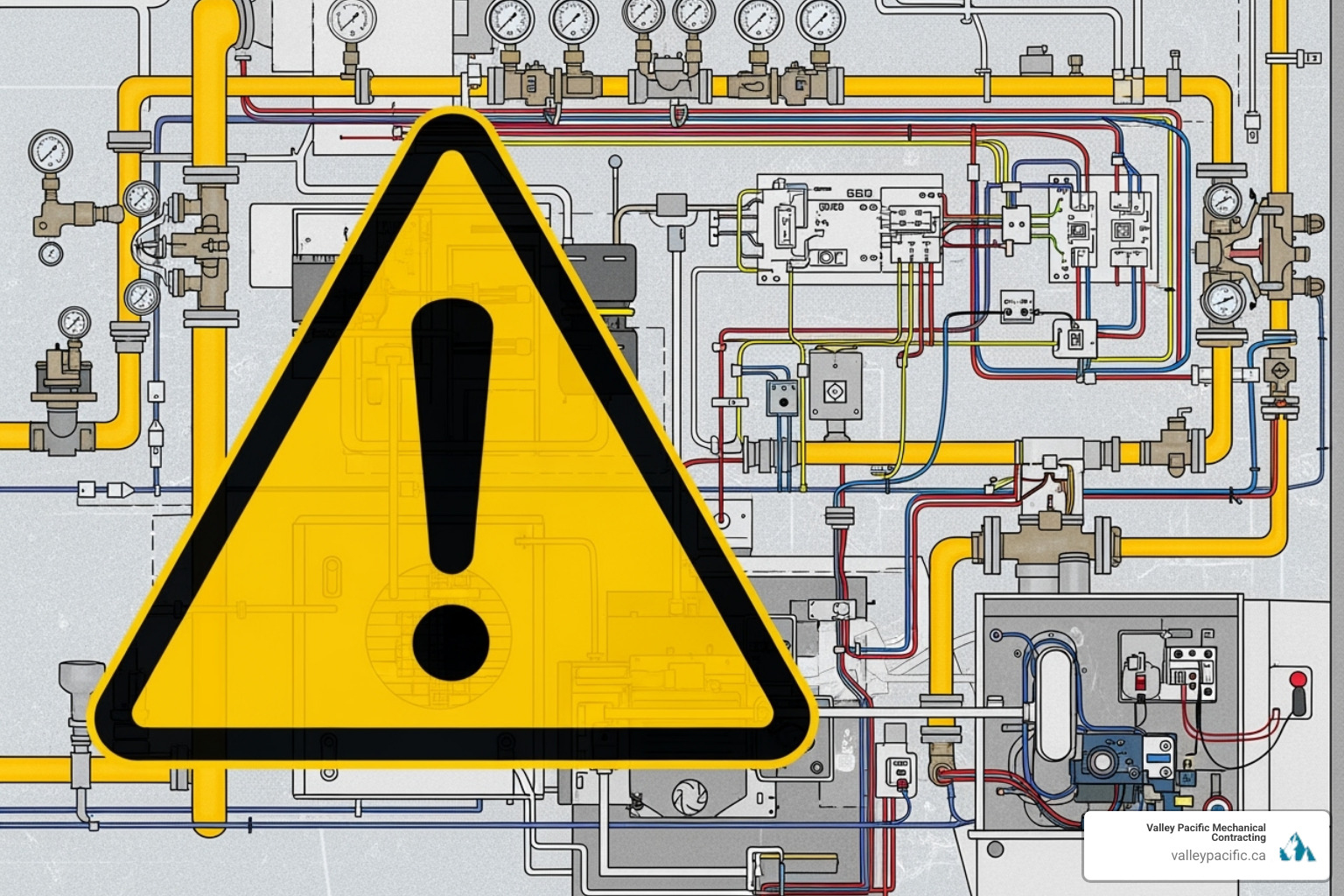
Research shows that improper installation can lead to a 30% reduction in performance and 10-30% higher utility bills for the life of your system. An improperly installed unit will also work harder and break down sooner. What seems like a cost-saving measure can cost you thousands in the long run. A professional forced air furnace installation is an investment that pays for itself through reliable performance, energy savings, and peace of mind.
The Dangers of DIY Forced Air Furnace Installation
Attempting a furnace installation yourself is genuinely dangerous. Here are the primary risks:
- Gas Leaks: An improperly sealed gas line connection is a serious fire or explosion hazard.
- Electrical Hazards: Incorrect wiring can cause electrical shorts, damage your new furnace, or lead to a house fire.
- Carbon Monoxide: Improper venting, especially with high-efficiency units, can lead to the buildup of deadly carbon monoxide gas in your home.
- Voided Warranties: Most manufacturers require professional installation to keep the warranty valid. A DIY job could leave you without coverage.
- Code Violations: DIY installations often fail to meet local building codes, which can cause issues when selling your home or with insurance claims. For professional help, contact us for Furnace Repair in Maple Ridge, BC.
Signs of a Quality Forced Air Furnace Installation
A quality installation has several clear indicators:
- A Level Unit with Sealed Connections: The furnace should sit perfectly level, and all ductwork connections must be sealed with mastic or foil tape, not standard duct tape.
- Neat Wiring and Piping: Electrical wires, gas lines, and vent pipes should be cleanly routed, secured, and clearly labeled.
- Proper Venting Slope: For high-efficiency models, PVC vent pipes must have a consistent downward slope to allow for proper condensate drainage.
- A Detailed Commissioning Report: This report documents the system's performance tests (static pressure, temperature rise, etc.) and proves it was optimized for your home.
- Homeowner Walkthrough and Education: The installer should explain how your new system works, demonstrate filter changes, and answer all your questions.
Life After Installation: Maintenance and Longevity
After your forced air furnace installation, proper care ensures your new system serves you faithfully for its full 15-20 year lifespan. A quality installation is the best start, but regular maintenance is what guarantees decades of reliable service, lower energy bills, and fewer breakdowns.
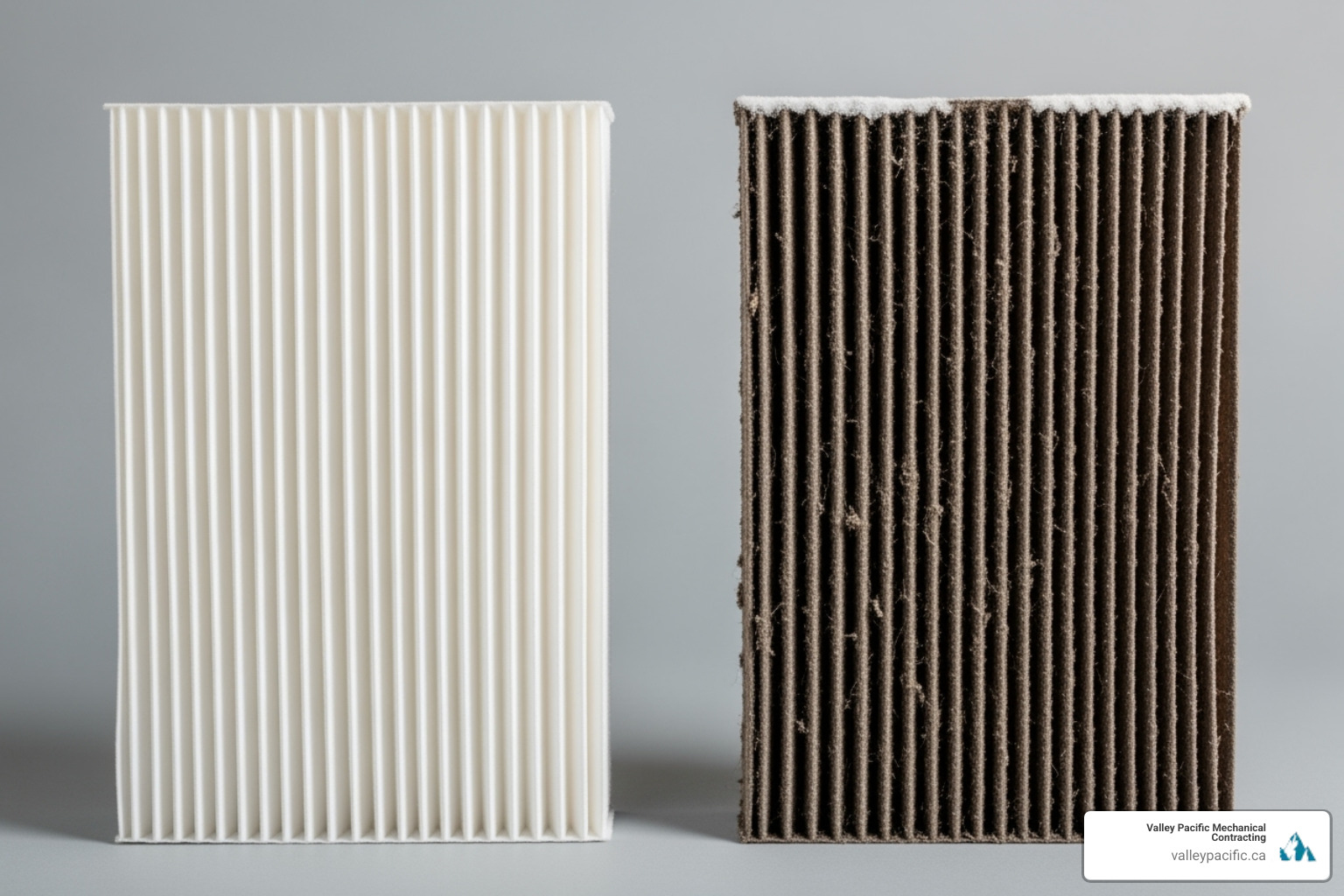
The average life expectancy of a new gas furnace is 15 years, largely as a result of varying levels of installation quality. A properly installed and maintained system can easily last 20 years or more.
Essential Furnace Maintenance for Homeowners
Some of the most important maintenance tasks are simple and can be done by you:
- Replace Air Filters: A dirty filter restricts airflow, forcing your furnace to work harder. Check your filter monthly and replace it every 1-3 months.
- Keep Registers Clear: Ensure furniture, rugs, or curtains are not blocking supply vents or return air grilles.
- Check the Thermostat: Ensure it's set correctly and replace batteries in digital models as needed.
For more guidance, explore our HVAC Preventative Maintenance resources. When you need professional support, we offer complete Furnace Services in Maple Ridge, BC.
The Importance of Annual Professional Tune-Ups
An annual professional tune-up is like a physical for your furnace. Our certified technicians perform safety inspections, clean internal components like burners and the heat exchanger, lubricate moving parts, and conduct efficiency testing. This catches small issues before they become big problems and maintains the peak performance your quality forced air furnace installation made possible. A well-maintained system runs quieter, heats more evenly, and keeps energy bills low.
Ready to schedule a tune-up? Contact us for expert Heating Service in Maple Ridge, BC.
Frequently Asked Questions about Forced Air Furnaces
Here are answers to common questions we receive about forced air furnace installation and operation.
How does a furnace interact with my thermostat and ductwork?
Think of your heating system as a team:
- The Thermostat (The Brain): It monitors your home's temperature and tells the furnace when to turn on.
- The Furnace (The Heart): It receives the signal, creates heat, and the blower fan pushes the warm air into the ducts.
- The Ductwork (The Circulatory System): It delivers warm air to every room and brings cooler air back to the furnace to be reheated.
When these three components are properly integrated through a quality forced air furnace installation, you get consistent, efficient comfort.
What are common furnace installation problems to avoid?
These preventable mistakes are the most common issues we see:
- Improper Sizing: A furnace that is too large or too small will waste energy and provide poor comfort.
- Leaky Ductwork: Unsealed connections allow heated air to escape into walls or attics, wasting money.
- Incorrect Venting: This can be dangerous, potentially causing moisture damage or carbon monoxide leaks.
- Skipping Commissioning: Without this final calibration step, your furnace may never achieve its rated efficiency.
- Choosing an Unqualified Installer: This is the root cause of most problems. Always work with licensed, experienced professionals to protect your investment and your family's safety.
Can a forced air system also provide air conditioning?
Yes! This is a major benefit of a forced air system. The furnace's blower and ductwork can be shared with a central air conditioning system. An evaporator coil is installed with the furnace, and in the summer, the same blower fan circulates cool, dehumidified air throughout your home. This integrated approach provides year-round climate control using a single, efficient system.
To learn more about our comprehensive heating and cooling solutions, check out our full range of Services.
Your Partner for a Headache-Free Furnace Installation
Your forced air furnace installation is a long-term investment in your family's comfort, safety, and energy efficiency. From the initial load calculation to the final commissioning tests, every step is crucial for ensuring reliable warmth for the next 15-20 years.
A professional installation prevents the issues that can slash your furnace's efficiency by up to 30% and lead to higher utility bills. More importantly, it gives you peace of mind.
At Valley Pacific Mechanical Contracting, we have been perfecting forced air furnace installation for over 30 years across the Lower Mainland, including Mission, Maple Ridge, and Langley. Our certified technicians craft heating solutions, not just install equipment. Every connection is tested for safety, every seal is checked for efficiency, and every control is verified to protect your home.
We are committed to delivering a truly headache-free experience, backed by our 24/7 emergency service and the Daikin Comfort Promise. The long-term value of professional work is realized through lower energy bills, safe operation, and decades of reliable service.
Ready to transform your home's comfort with a professional forced air furnace installation? We're here to guide you every step of the way.
Schedule Your Professional Forced Air Furnace Installation in Langley, BC and experience the Valley Pacific difference today!




